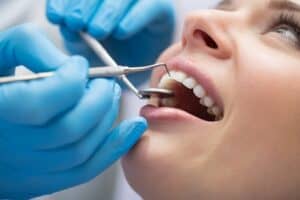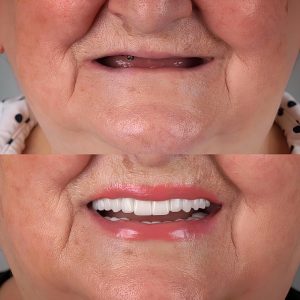Restorative Dentistry in New Carlisle, OH

What Restorative Dentistry Services Do We Offer?
Fillings
Dental fillings are used to repair teeth that have been damaged by cavities. A composite resin material (matching the color of the natural tooth) is placed in the tooth in order to strengthen its structure and protect it from further decay.
Root Canal Treatment
When a tooth has become infected, we can often save it from needing extraction by performing root canal treatment. A root canal is used to preserve the natural tooth by removing the infected tooth pulp and nerve. A dental crown is then placed over the treated tooth to prevent further infection and preserve tooth function.
Crowns
A dental crown is a cap (made of porcelain or another durable material) that is placed over a tooth to strengthen it and cover any aesthetic problems, for a more appealing smile. Dental crowns are used to restore the function and form of teeth that are broken, misshapen, damaged by decay or trauma, or weakened by mercury fillings or root canal treatment. They are also used in treatment with dental implants and bridges.
Bridges
For patients who are missing one or more teeth, a dental bridge can be used to fill in the gap, providing a stronger, more attractive smile. A dental bridge is secured firmly and permanently in the mouth by being attached to crowns placed on adjacent teeth. The placement of a dental bridge is used to resolve problems caused from having missing teeth, including difficulty speaking and chewing, shifting teeth and jaw problems from an uneven bite.
Dental Implants
Dental implants are oral appliances that are used for the replacement of one or more missing teeth. A dental implant’s structure includes a metal post or screw that is placed in the jawbone. Once the metal base fuses with the jawbone, it creates a sturdy support system for a replacement tooth that sits on top of the gums. The replacement tooth is matched in color to the surrounding teeth, providing a gap-free, natural-looking smile.
Dentures
Patients who are missing the majority, or all, of their teeth as a result of aging, decay or trauma often choose to replace them with dentures. Our practice offers both partial and full dentures, based on the amount of teeth being replaced. Full dentures consist of upper and lower dentures, each with a full row of replacement teeth attached to plastic material that resembles gum tissue. A partial denture is a bridge made of a gum-colored plastic with replacement teeth. It fits in the gap left by your missing teeth. Metal clasps are used to secure the partial denture in place; for a fixed partial denture, the metal is fused to your surrounding tooth for a secure, permanent fit. Both full and partial dentures are custom-made to fit your bite, for a comfortable fit.
Restorative Dentistry FAQ
What Are the Benefits of Having Restorative Dentistry?

What’s the Difference between Restorative and Cosmetic Dentistry?
Restorative dentistry primarily focuses on restoring the function and structural integrity of your teeth, using procedures like fillings, crowns, bridges, and implants. Cosmetic dentistry, on the other hand, primarily aims to improve the appearance of the teeth and smile. It includes treatments like teeth whitening, veneers, and bonding. While both branches may overlap — such as using a crown for both restoring a tooth and improving its appearance — the primary objectives differ. Rest assured that Dr. Miller considers aesthetics in every restorative procedure she performs to ensure outcomes that are both functional and attractive.
What Happens During a Consultation for Restorative Dentistry?
During a consultation for restorative dentistry, Dr. Miller will conduct a comprehensive examination of your teeth, gums, and overall oral health to assess the extent of any damage or decay. This evaluation may include digital X-rays or 3D imaging to get a detailed view of your teeth structures and jawbone. Based on this assessment, Dr. Miller will discuss your treatment options, expected outcomes, and the steps involved in each procedure. This consultation also provides an opportunity to address any questions or concerns you may have about your treatment plan.
Does Insurance Cover Restorative Dentistry Procedures?
Many restorative dentistry procedures are covered by dental insurance, especially those deemed medically necessary, such as fillings, crowns, and bridges. However, the extent of coverage can vary significantly based on your specific insurance plan and the treatment you need. It is advisable to consult with your insurance provider to understand the details of what is covered. Dr. Miller’s office can also assist you in estimating costs and navigating your insurance benefits to ensure you receive the maximum coverage available.
How Long Do Restorative Treatments Last?
The longevity of restorative treatments can vary based on the type of procedure, the materials used, and the patient’s oral hygiene and habits. For instance, dental fillings can last anywhere from five to 15 years, while crowns and bridges may last 15 years or more. Dental implants are often considered a permanent solution, potentially lasting a lifetime with proper care.
What Should I Expect after a Restorative Procedure?

Trust Us to Restore Your Smile Back to Health
Our full-service practice is known for offering dental solutions that change people’s lives, restoring their ability to laugh, smile, eat and simply enjoy the benefits of a healthy, beautiful smile. If you suffer from missing or damaged teeth, or another oral health problem that gets in the way of your daily life, talk to one of our dental professionals to learn about your treatment options. Contact us today to schedule your appointment.
